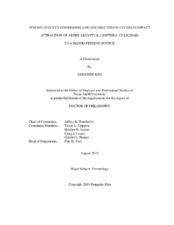| dc.description.abstract | Aedes aegypti, is a vector of pathogens transmitting many infectious diseases, such as Zika, Dengue, and Yellow Fever. Skin-inhabiting bacteria, such as Staphylococcus epidermidis, produce specific volatile organic compounds (VOCs) which participate in attracting mosquitoes to human hosts. However, little is known about the ecology of the bacteria and its role in mosquito behavior; specifically whether bacterial communication through quorum sensing (QS) modulates mosquito behavior. This study determined if the QS system could be manipulated chemically (e.g., quorum sensing inhibitor (QSI), C-30, furanone) to suppress mosquito responses. The results showed disrupting QS by S. epidermidis with an inhibitor (QSI) reduced the VOC composition by 35.0% and suppressed mosquito attraction by 55.1%. To explore further questions, mycolactone as a potential QS compound produced by the environmental pathogen, Mycobacterium ulcerans, regulating mosquito behavior was determined. A blood-feeder treated with M. ulcerans wildtype elicited a 126.0% and 171.0% greater attraction than M. ulcerans mutant or control, respectively. In terms of polymicrobial interactions, the addition of M. ulcerans to S. epidermidis resulted in 23.7% and 72.1% greater mosquito attraction than S. epidermidis and M. ulcerans alone. Most interestingly, S. epidermidis concentrations are typically low on the extremities. In this study, an interdisciplinary approach was used to elucidate the ecological ramifications associated with interkingdom cross-talk between bacteria and eukaryotic.
This knowledge can lead to the development of a new class of odor-masking or inhibitory compounds as it is thought to be the less selective pressure than pre-existing pesticide or repellent use, which can be exploited in the protection from mosquito bites, aiming at compounds that reduce the production of attractive volatiles on the human skin. It has a broad range of potential applications in agriculture, medicine, pest-management, and etc. | en |


